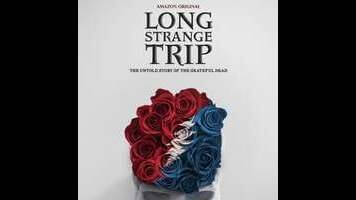The magnificent Long Strange Trip captures the splendor and folly of the Grateful Dead

Some of the most surprisingly gripping passages in Dennis McNally’s 2001 book A Long Strange Trip: The Inside History Of The Grateful Dead have to do with amplifiers. The band’s longtime publicist spent decades with the Dead, and watched them shrug off major details of their business—like getting their songs just right in a recording studio or keeping track of their income—while practically tearing each other apart over the small stuff. In 1974, frontman Jerry Garcia and his mates poured money and man-hours into developing a sound system so loud and so clear that at outdoor concerts the music would sound pristine a half-mile away. They knew that the best way to experience the band was at a live show, surrounded by fellow pilgrims, grooving to every note of otherworldly improvisations. So that’s where they directed their resources: to positioning the speakers.
Any Deadheads out there who might be wavering about whether or not to watch Amir Bar-Lev’s nearly four-hour documentary, Long Strange Trip, should know that not only is McNally one of the interview subjects, but that the film also dedicates a good 10 to 15 minutes to that stack of amps, dubbed the Wall Of Sound. Bar-Lev also takes a long detour to cover the phenomenon of Dead bootlegs and to ask some famous fans—including Senator Al Franken—about their favorite tapes. There are sections of Long Strange Trip that discuss how Garcia’s bluegrass roots inspired the way he liked to interact with the band onstage and sections that deal with the decision to simplify the writing and recording process for the classic Workingman’s Dead and American Beauty albums, as well as a tearjerking anecdote about how the Europe ’72 recording of “Morning Dew” came to be. This movie doesn’t skimp on the arcana—not all of which will be common knowledge even to die-hards.
And non-Deadheads? They should know that Long Strange Trip (which comes to Amazon Prime on June 2 after a limited theatrical release) is a strong piece of documentary filmmaking and not mere fan service. That’s evident in the way Bar-Lev uses those bits of Grateful Dead ephemera. He follows a narrative model mastered by Ken Burns, where seemingly minor tidbits from history serve as a way into something larger. For example, when Long Strange Trip digs into the culture and hierarchy of the band’s roadies, that soon winds its way into observations on what it cost to maintain the Dead’s enormous touring “Family,” and then into a mention of how the pace of life on the road led to a shift from gentle psychedelics to harder drugs, which in turn made the complexity of the music onstage harder to achieve. Bar-Lev understands how the little things matter.
The film’s extended running time—which is about the length of a classic-era Grateful Dead concert—is divided into sections, just as the band would do with its shows. Bar-Lev proceeds in mostly chronological order, but doesn’t let the strictures of the timeline prevent him from following a theme wherever it leads, or from doubling back if he skipped something important. The basics of the Dead’s story are in the documentary, from the origins in the San Francisco folk and acid-rock scenes to their surprising explosion into arena dominance in the ’80s and ’90s. The movie then spends its most sustained stretch on the death of guitarist and guru Garcia, and what that loss meant to multiple generations of Deadheads. Always the emphasis is on analysis over raw facts.
That’s why, ultimately, even with all the rare live footage and insightful interviews, this is as much a film for people who admire the work of Bar-Lev as it is for people devoted to the Dead. In his films Fighter, My Kid Could Paint That, The Tillman Story, and Happy Valley, Bar-Lev has returned repeatedly to the idea that no matter how hard we try to craft and nurture personal mythologies, they can be reinterpreted and reshaped by time, circumstances, and the masses. The arc of Long Strange Trip doesn’t concern itself much with how the Grateful Dead recorded Blues For Allah and In The Dark. It’s more about how Garcia set out to create an artistic endeavor where the divisions between audience and creator would be obliterated, and where fleeting experiences were valued more highly than leaving behind any kind of permanent legacy; and how he then ended up a virtual captive to a massive money-making machine, catering to fans who kept extensive records of every gig.
Taken as a whole—or viewed from a distance—the tale Long Strange Trip tells could be seen as a pop tragedy. But despite how it ended, and despite how many special people were damaged or lost along the way, the journey itself included moments so singularly remarkable that they mostly mitigate the mistakes. The brilliance of Long Strange Trip is that Bar-Lev allows for multiple interpretations. Yes, this is a movie about the slow corruption of a noble ideal. But it never lets viewers forget that in the epic four-decade song that was the Grateful Dead, so many of the solos were stunning—and could be heard from the front of the stage to the parking lot.